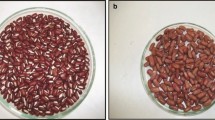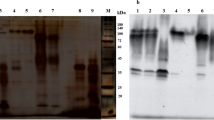Abstract
The objective of this study was to obtain purer acid phosphatases than produced by prior art by operating under conditions that improve the final product. The study features are the use of a mild nonionic detergent, 40–80% saturation with (NH4)2SO4, maintained at low temperature to remove impurity, and the use of chromatografic columns to concentrate the acid phosphatase and remove non-acid phosphatase proteins with lower or higher molecular weights. Acid phosphatase was isolated and purified from garlic seedlings by a streamline method without the use of proteolytic and lipolytic enzymes, butanol, or other organic solvents. Grown garlic seedlings of 10–15 cm height were homogenized with 0.1 M acetate buffer containing 0.1 M NaCl and 0.1% Triton X-100. After homogenization, the supernatant was filtered with paper filters. Filtrated supernatant was cooled to 4°C, followed by a threestep fractionation of the proteins with ammonium sulfate. The crude enzyme was isolated as a green precipitate that was dissolved in a small amount of 0.1 M acetate buffer containing 0.1 M NaCl and 0.1% Triton X-100. Garlic seedling acid phosphatase was purified with ion-exchange chromatography (DEAE cellulose). The column was equilibrated with 0.1 M acetate buffer. Acid phosphatase was purified 40-fold from the starting material. The specific activity of the pure enzyme was 168 U/mg. A variety of stability and activity profiles were determined for the purified garlic seedling acid phosphatase: optimum pH, optimum temperature, pH stability, temperature stability, thermal inactivation, substrate specificity, effect of enzyme concentration, effect of substrate concentration, activation energy, and effect of inhibitor and activator. The molecular mass of acid phosphatase was estimated to be 58 kDa by sodium dodecyl sulfate polyacrylamide gel electrophoresis. The optimum pH was 5.7 and the optimum temperature was 50°C. The enzyme was stable at pH 4.0–10.0 and 40–60°C. Activation energy was between 10 and 20 kcal, and as Michaelis Menten coefficients, V m values were 100 and 20 mM/s and K m values were 21.27 and 8.33 mM for paranitrophenylphosphate and paranitrophenyl, respectively. Studies of the effect of metal ions on enzyme activity showed both an activating and a deactivating effect. While Cu, Mo, and Mn showed strong inhibitory effects, Na, Ca, and K were the significant activators of acid phosphatase.
Similar content being viewed by others
References
Price, N. C. (1982), Fundamentals of Enzymology, Oxford University Press, Oxford, UK.
Guo, J., Pesacreta, T. C. (1997), Plant Physiol., 151, 520–527.
Kawarasaki, Y., Hiedo, N., and Yamane, T. (1996), Plant Sci. 119, 67–77.
Van Etten, R. L. and Waymack, P. P. (1991), Arch. Biochem. Biophys. 288, 621–623.
Hye-Shin, C. P. and Van Etten, R. L. (1986), Phytochemistry 25(2), 351–357.
Deveci, N. and Guvenilir, Y. (1995), Appl. Biochem. Biotechnol. 53.
Yoshimoto, M., Kimura, T., Miyamoto, T., Sakamoto, J., and Hatano, S. (1992), Biosci. Biotech. Biochem. 56(1), 147–148.
Van Etten, R. L. and Waymack, P. P. (1991), Arch. Biochem. Biophysics 288(2), 634–645.
Verissima Ferreira, C., Granjeiro, J., Taga, E., and Aoyama, H. (1986), Biochem. Biophys. Res. Commun. 242, 282–286.
Bose K. S. and Taneja V. (1998), Biochem. Biophys. Res. Commun. 25, 629–634.
Hayakawa, T., Toma, Y., and Igaue, I. (1989), Agric. Biol. Chem. 53(6), 1475–1483.
Author information
Authors and Affiliations
Corresponding author
Rights and permissions
About this article
Cite this article
Yenigün, B., Güvenilir, Y. Partial purification and kinetic characterization of acid phosphatase from garlic seedling. Appl Biochem Biotechnol 107, 677–687 (2003). https://doi.org/10.1385/ABAB:107:1-3:677
Issue Date:
DOI: https://doi.org/10.1385/ABAB:107:1-3:677




